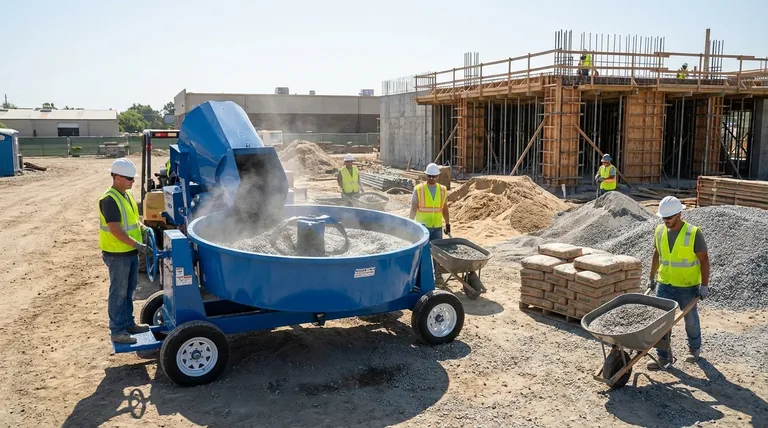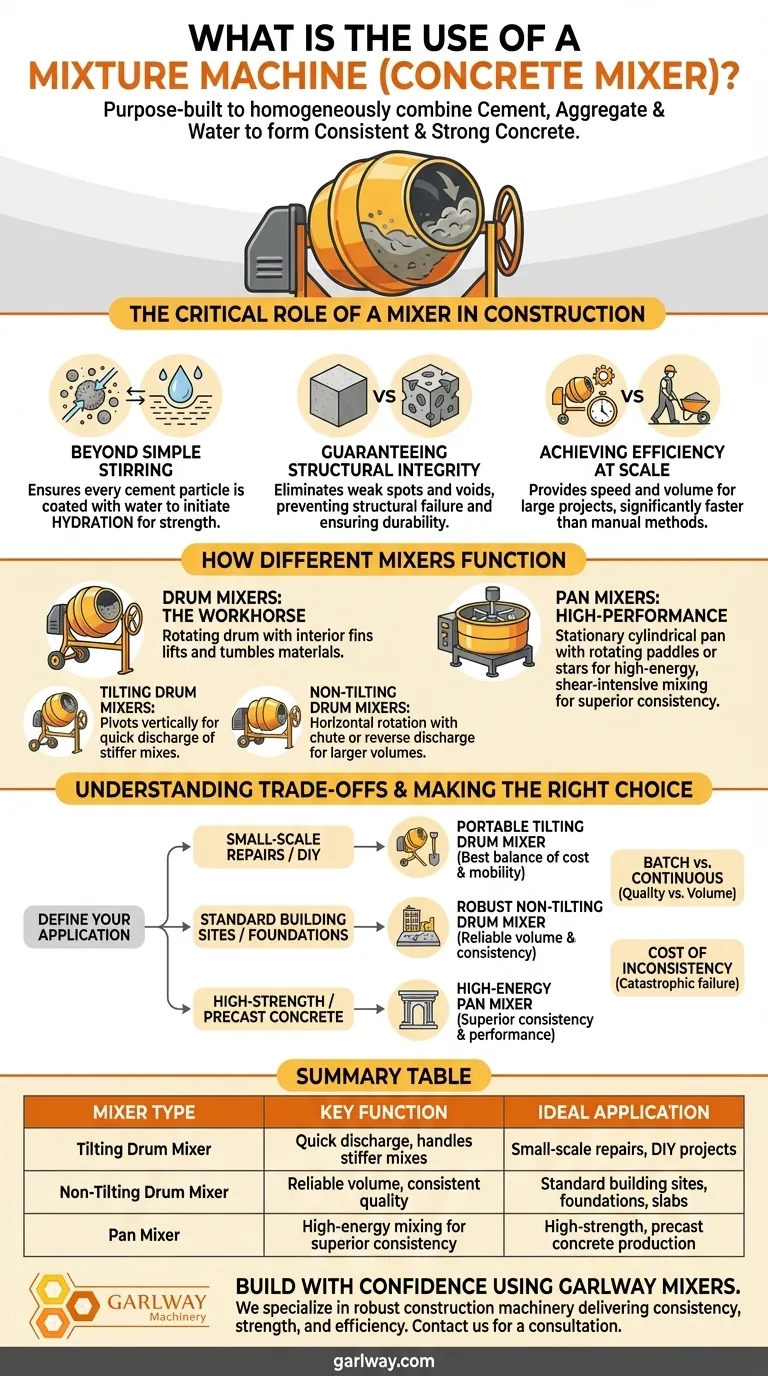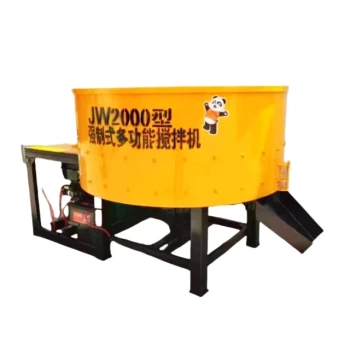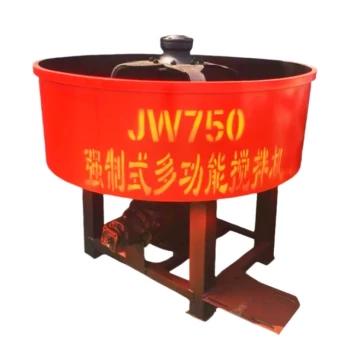At its core, a "mixture machine," known professionally as a concrete mixer, is a device purpose-built to homogeneously combine cement, aggregate (such as sand and gravel), and water to form concrete. Its primary use is to automate this process, ensuring a consistent and workable mixture that is essential for modern construction projects, from small foundations to large-scale infrastructure.
The true purpose of a concrete mixer isn't just to stir ingredients; it's to guarantee the consistency, strength, and structural integrity of the final concrete, a feat impossible to achieve reliably at scale through manual methods.

The Critical Role of a Mixer in Construction
A concrete mixer is the starting point for creating durable, reliable structures. Its function goes far beyond simple agitation; it initiates a crucial chemical process under controlled conditions.
Beyond Simple Stirring
Mixing concrete is not like mixing a cake batter. The goal is to ensure every particle of cement is coated with water to begin the chemical reaction known as hydration. This reaction is what gives concrete its strength, and a mixer ensures it happens uniformly throughout the batch.
Guaranteeing Structural Integrity
Inconsistent mixing creates weak spots and voids within the concrete. These imperfections can severely compromise the load-bearing capacity and long-term durability of a foundation, column, or slab. A mixer eliminates this risk by producing a predictable, homogenous material every time.
Achieving Efficiency at Scale
As noted for large construction sites, manual mixing is impractical and slow. A concrete mixer provides the speed and volume necessary to keep projects on schedule. It allows crews to produce cubic meters of concrete in the time it would take to manually mix a single wheelbarrow.
How Different Mixers Function
While the goal is the same, different types of mixers are designed for specific scales and applications. The most common category is the drum mixer.
Drum Mixers: The Workhorse of Construction
This is the most recognizable type of mixer. It uses a rotating vessel, or drum, with interior fins or blades that lift and tumble the materials to combine them.
There are two primary kinds of drum mixers:
- Tilting Drum Mixers: The entire drum pivots vertically to discharge the finished concrete. This design allows for a very quick and complete discharge, making it ideal for stiffer concrete mixes.
- Non-Tilting Drum Mixers: The drum rotates on a horizontal axis and does not tilt. Discharge is handled by inserting a chute into the drum or by reversing the direction of rotation. These are often used for larger volumes and more fluid mixes.
Pan Mixers: For High-Performance Concrete
Instead of a rotating drum, a pan mixer uses a stationary cylindrical pan with rotating paddles or stars inside. This high-energy, shear-intensive action is excellent for creating highly consistent, high-strength concrete, often used in precast concrete plants.
Understanding the Trade-offs
Choosing the right mixer involves balancing efficiency, quality, and cost. There is no single best solution for every job.
Batch vs. Continuous Mixing
Most mixers you see on-site are batch mixers (like drum or pan types), which produce concrete one load at a time. This offers excellent quality control. Continuous mixers are used in massive projects like dams, where an uninterrupted flow of concrete is required, trading some fine control for immense volume.
Portability vs. Capacity
Small, portable drum mixers are perfect for minor repairs, fence posts, or small slabs. In contrast, large construction sites rely on stationary batching plants or large-capacity mixer trucks that can deliver ready-mix concrete directly where it's needed.
The Cost of Inconsistency
Using a mixer that is too small for a job can lead to "cold joints"—weak points where one batch of concrete begins to set before the next one is poured against it. Conversely, underutilizing a large mixer is inefficient. The primary cost, however, always comes from poor mixing, which can lead to catastrophic structural failure.
Making the Right Choice for Your Goal
Your specific application dictates the appropriate type of mixer.
- If your primary focus is small-scale repairs or DIY projects: A portable tilting drum mixer provides the best balance of cost, mobility, and ease of use.
- If your primary focus is a standard building site for foundations or slabs: A robust non-tilting drum mixer offers the reliable volume and consistent quality required for intensive work.
- If your primary focus is producing high-strength or architectural precast concrete: A pan mixer is the only choice to guarantee the superior consistency and performance needed.
Ultimately, understanding the function of a concrete mixer is the first critical step in building a safe and enduring structure.
Summary Table:
| Mixer Type | Key Function | Ideal Application |
|---|---|---|
| Tilting Drum Mixer | Quick discharge, handles stiffer mixes | Small-scale repairs, DIY projects |
| Non-Tilting Drum Mixer | Reliable volume, consistent quality | Standard building sites, foundations, slabs |
| Pan Mixer | High-energy mixing for superior consistency | High-strength, precast concrete production |
Build with Confidence Using GARLWAY Mixers
For construction companies and contractors, the right concrete mixer is the foundation of every successful project. GARLWAY specializes in robust construction machinery, offering a range of concrete mixers and batching plants designed to deliver the consistency, strength, and efficiency your work demands.
Let us help you choose the perfect equipment to guarantee the structural integrity of your builds. Contact GARLWAY today for a consultation and elevate your construction quality.
Visual Guide

Related Products
- Ready Mixer Machine for Construction Ready Mix Machinery
- Commercial Construction Mixer Machine for Soil Cement Mixing Concrete
- Auto Concrete Cement Mixer Machine New
- HZS90 Large Multiquip Concrete Mixers for Construction
- JDC350 Small Cement Concrete Mortar Mixer
People Also Ask
- Why is the manufacturer's strength and service important when choosing a concrete mixer? Ensure Long-Term Project Success
- Can a concrete mixer be used for mortar? Understanding the trade-offs for your project
- What is the average lifespan of a concrete mixer? Maximize Your Equipment's Lifespan & ROI
- Which type of projects require a concrete mixer? Essential Guide for Construction Pros
- What was significant about Roscoe Lee's 1934 concrete mixer design? Pioneering Modular Construction Equipment
















